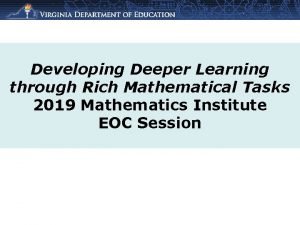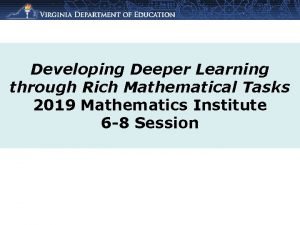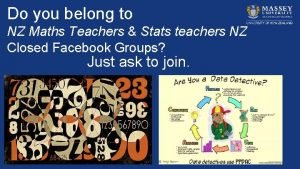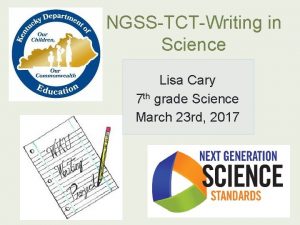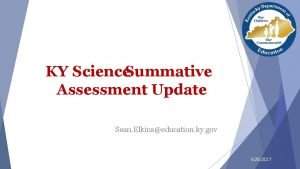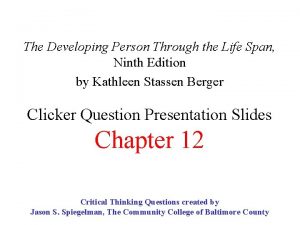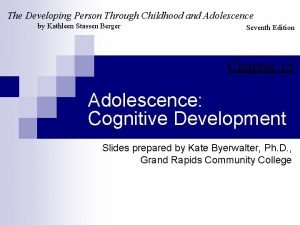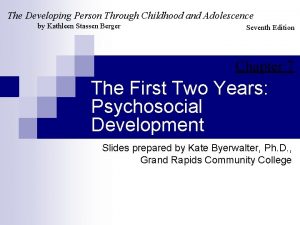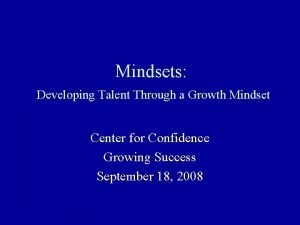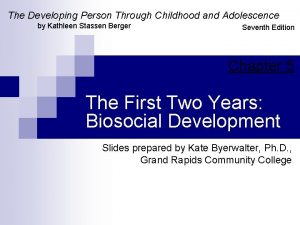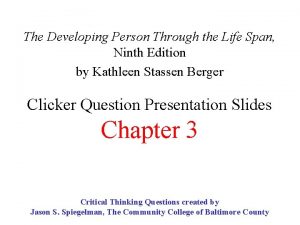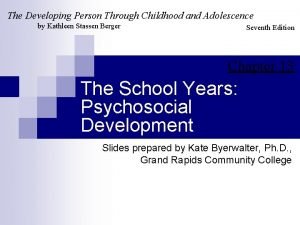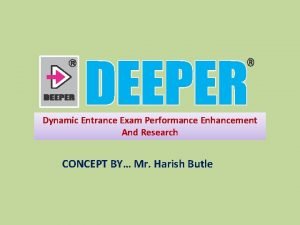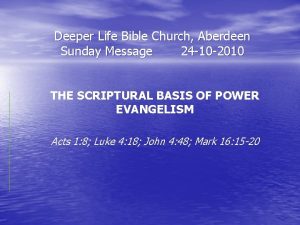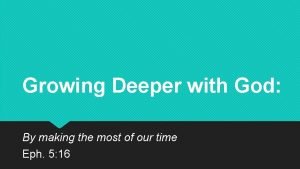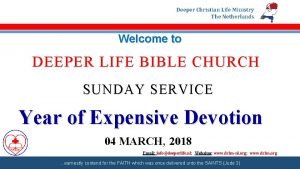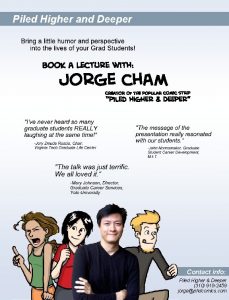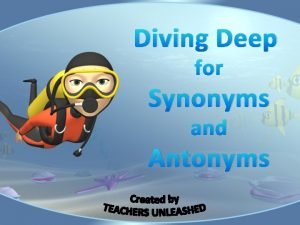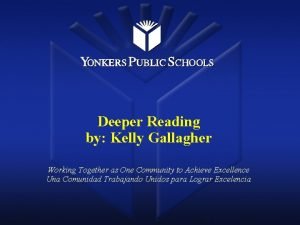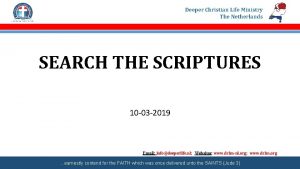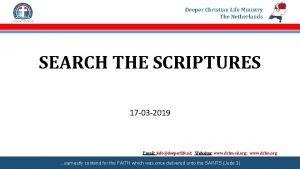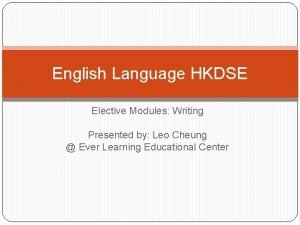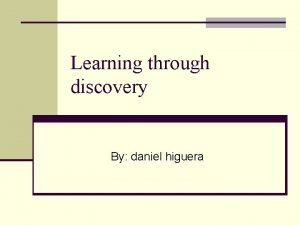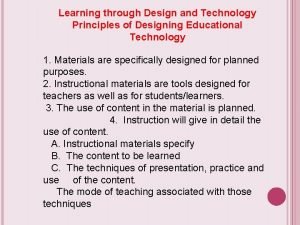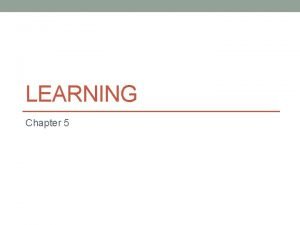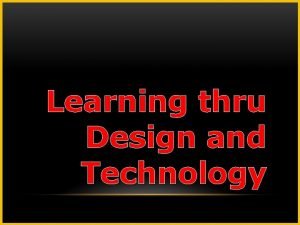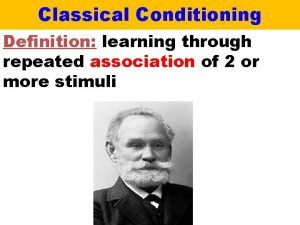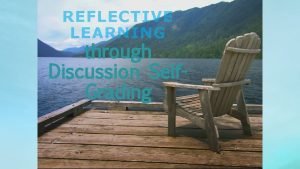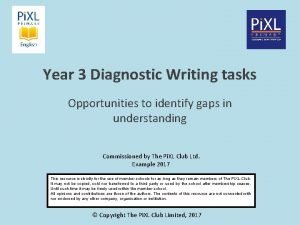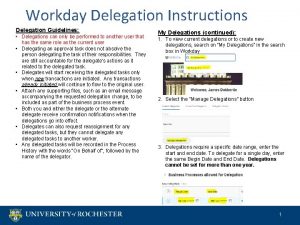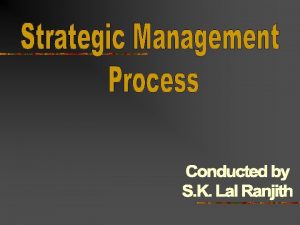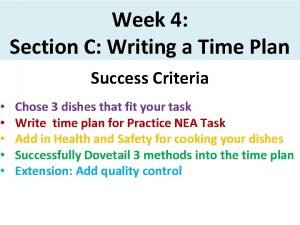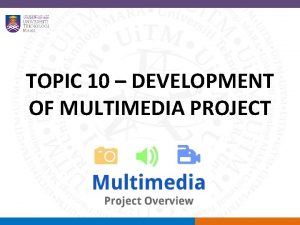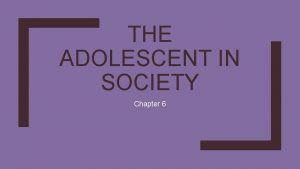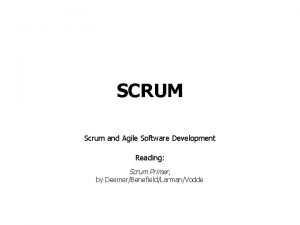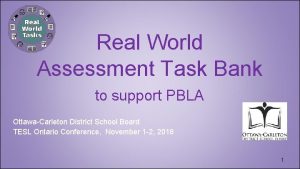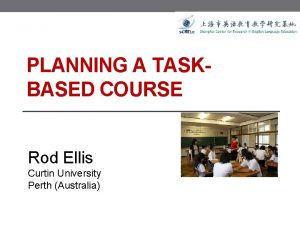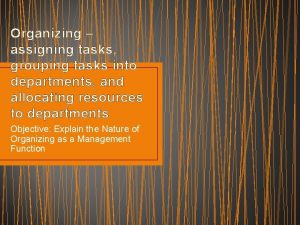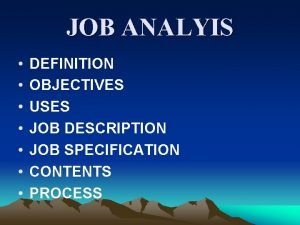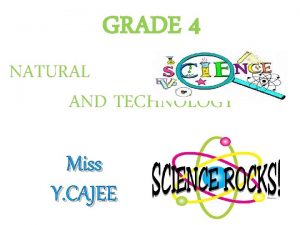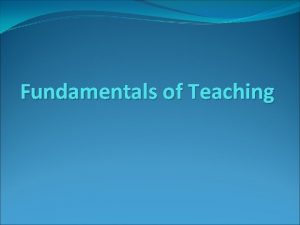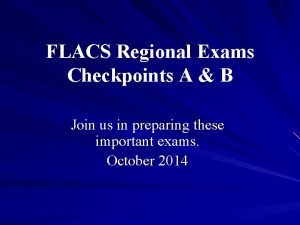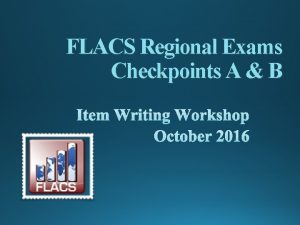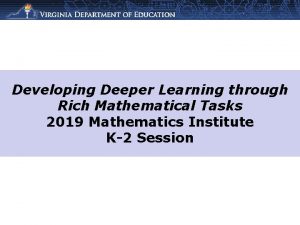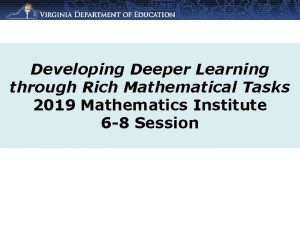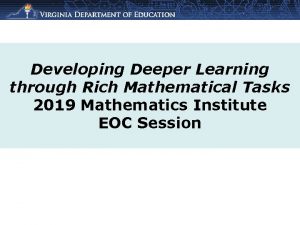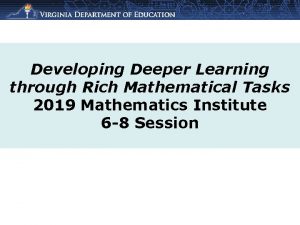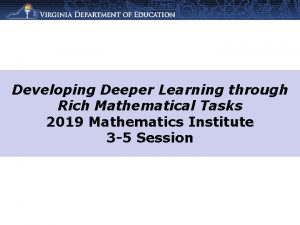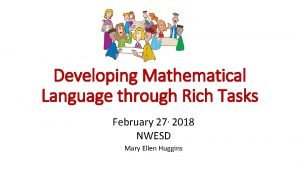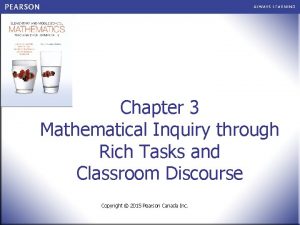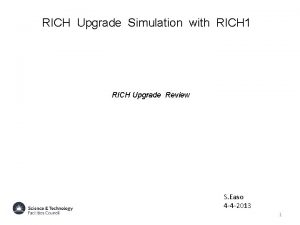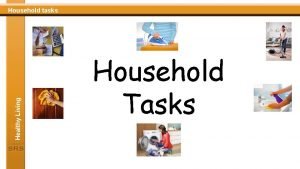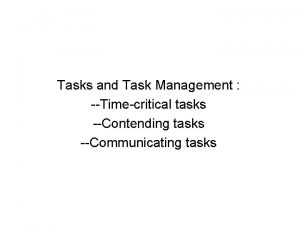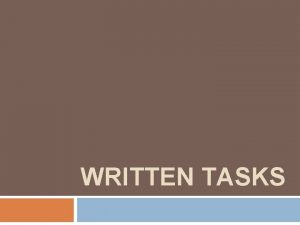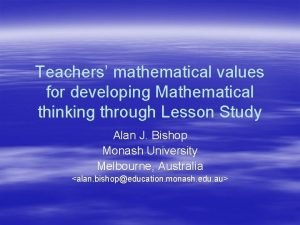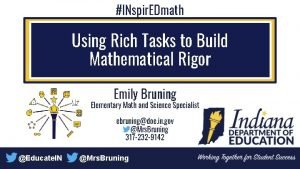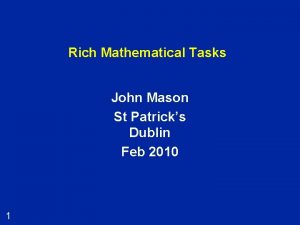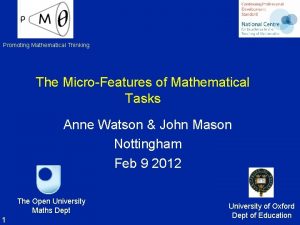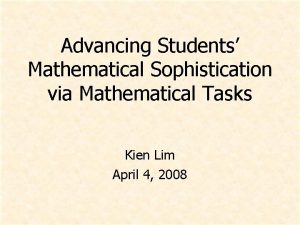Developing Deeper Learning through Rich Mathematical Tasks 2019






















































































- Slides: 86

Developing Deeper Learning through Rich Mathematical Tasks 2019 Mathematics Institute EOC Session

Welcome and Introductions

Opening Video Message from VDOE 3

Focus of 2019 Mathematics Institutes Establish mathematics goals to focus learning. Implement tasks that promote reasoning and problem solving. Build procedural fluency from conceptual understanding. Facilitate meaningful mathematical discourse. Pose purposeful questions. Use and connect mathematical representations. Elicit and use evidence of student thinking. Support productive struggle in learning mathematics. Adapted from Smith, M. et al. (2017) Taking Action – Implementing Effective Mathematics Teaching Practices Series, National Council of Teachers of Mathematics. 4

Logistics • • • Parking Lot Restroom Locations Breaks Strategy Catcher Charging Devices Wi-Fi Access 5

Community Builder Stand up if: 6

Just Like Me Stand up if you are a pet owner 7

Just Like Me Stand up if you have used tasks in your classroom 8

Just Like Me Stand up if you drove over an hour to get here today. 9

Just Like Me Stand up if you have scored student work with a rubric before. 10

Just Like Me Stand up if you have been teaching less than five years. 11

Just Like Me Stand up if you have an administrative role. 12

Just Like Me Stand up if you have heard of visible learning. 13

Just Like Me Stand up if you believe you have an impact on student learning. 14

Agenda Morning Session • Module I: Overview – Visible Learning, Equity, and Identity (includes VDOE Video Overview) • Module II: Task Implementation (Before) Afternoon Session • Module III: Task Implementation (During/After) • Module IV: Assessing Student Understanding • Reflection and Closure 15

Session Learning Intentions Content: • I am learning about strategies and approaches that make teaching and learning more visible. Language: • I am learning to use the language of a visible learning mathematics classroom. Social: • I am learning how to listen and respond to my colleagues’ ideas in ways that move everyone forward as learners. 16

Module I Overview – Visible Learning, Equity, and Identity

Module I: Success Criteria ● I can recognize strategies in teaching and learning that have high impacts (effect size) on student achievement. ● I can recognize and support equitable learning opportunities for all students that promote positive student mathematical identity and agency. ● I can describe how to create a classroom environment that supports the development of assessment-capable mathematics learners. 18

Anticipation Reaction Guide • Before the video… • Answer True (T) or False (F) • Watch the Video • During/After the video… o Adjust Answer True (T) or False (F) o Rewrite False Statements 19

Anticipation Reaction Guide Key 1. 2. 3. 4. 5. True False True 6. True 7. True 8. False 9. True 10. False Share corrections to false statements. 20

Barometer of Influence and Effect Size Adapted from Hattie, J. (2009) Visible Learning: A Synthesis of Over 800 Meta-analyses Relating to Achievement. New York, NY: Routledge. 21

Effect Size Sort 22

Math Identity and Equity 23

Math Timeline 24

The Five Equity-Based Mathematics Teaching Practices 1. Go deep with mathematics (Deeper Learning) 2. Leverage multiple mathematical competencies 3. Affirm mathematics learners’ identities 4. Challenge spaces of marginality 5. Draw on multiple resources of knowledge Resource: Smith, M. et al. (2017) Taking Action – Implementing Effective Mathematics Teaching Practices Series, National Council of Teachers of Mathematics. 25

A Visible Learning Classroom is. . . Teachers Learners Predict: What does visible teaching look like in a classroom? What does visible learning look like in a classroom? 26

Comparing Visible Teaching & Learning Vi s Visible Teaching ibl e. L Visible Learning e Clearly communicates the learning intention a B Pa ook rnin ge g the So that learners understand 2 0 intention of the learning experience. Identifies challenging success criteria So that learners know what success looks like. Utilizes a range of learning strategies So that learners develop a range of learning strategies. Continually monitors student learning So that learners know when they are not progressing and can make adjustments. So that learners can seek feedback about their learning. Provides feedback to learners 27 Source: John Almarode, Douglas Fisher, Joseph Assof, John Hattie, and Nancy Frey (2019)

Vi sib Assessment-Capable Visible Learner le Le Bo ar Pa ok ni ng ge 12 28

Mistake-Friendly Classroom Mistakes are not only opportunities for learning, as students consider the mistakes, but also times when our brains grow. Understanding the power of mistakes is critical, as children and adults everywhere often feel terrible when they make a mistake in math. They think it means they are not a math person, because they have been brought up in a performance culture (see Boaler, 2014) in which mistakes are not valued—or worse, they are punished. You cubed 29

Jigsaw Reading Vi sib le Le B Pa oo arni ge k ng • Form groups of 3 and number off. 21 • Read the pages based on your number, starting with-3 the 5 following section titles: 1. Surface, Deep, and Transfer Learning (pgs. 21 -25) 2. Moving Learners Through the Phases of Learning (pgs. 26 -31) 3. Differentiating Tasks for Complexity and Difficulty (pgs. 31 -35) • Come back together and discuss common themes from the sections you read. 30

Surface, Deep, and Transfer. Visi ble Learning in Math L B ea Pa ook rnin ge g 22 Ongoing assessments inform teachers that students are in various places along this path, and sometimes will move interchangeably between these phases of learning. It is the teacher’s goal to provide interventions and strategies students need at the right time for the right 31 reason.

The “Goldilocks” Effect A Visible Learning classroom uses… the right strategy at the right time, for the right level of thinking, with the right level of challenge. 32

Square, Circle, Triangle Reflection Based on Module I. . . What is one idea that squared with your thinking? What is a question circling in your mind? What point(s) would you like to remember, that might impact your work? 33

Module II Task Implementation (Before)

Module II: Success Criteria • I can identify how teacher clarity about learning intentions and success criteria contributes to student success. • I can distinguish between tasks that will engage students in higher levels of cognitive demand versus lower levels of cognitive demand. • I can describe the factors associated with the decline or maintenance of the cognitive level of a rich mathematical task. • I can anticipate student solution strategies and misconceptions associated with the implementation of a mathematical task. 35

Vi sib Learning Intentions and Success le Le P B Criteria ag oo arni e k n s 4 g 8 • Learning intentions - describe what teachers want students 50 to learn from the lesson. – Content: “What is the math I am supposed to use and learn today? ” – Language: “How should I communicate my mathematical thinking today? ” – Social: “How should I interact with my learning community today? ” • Success criteria is meant to describe what success looks like when a student has reached the learning goal. Clear Learning Intentions Rich Mathematical Tasks Progress Toward Mastery 36

Grouping Activity – How Many Fingers? (No more than 4 to a group) • Algebra I - Hold up 1 finger and find a group member with the same number • Algebra II - Hold up 2 fingers and find a group member with the same number • Geometry - Hold up 3 fingers and find a group member with the same number 37

Create Learning Intentions and Success Criteria for a Task. . . • Algebra I - Solving a system of linear equations • Algebra II - Characteristics of functions with a focus on quadratics and modeling • Geometry - Applications of right triangles Clear Learning Intentions Rich Mathematical Tasks Progress Toward Mastery 38

Does the Task Match? • Read the task for your content and compare to the Learning Intentions and Success Criteria your group created. • Does the task satisfy your Learning Intentions? Clear Learning Intentions Rich Mathematical Tasks Progress Toward Mastery 39

How do tasks and their implementation impact mathematics learning? Student learning is greatest in classrooms where the tasks consistently encourage high‐ level student thinking and reasoning and least in classrooms where the tasks are routinely procedural in nature. - Boaler and Staples 2009; Hieber and Wearne 1993; Stein and Lane 1996 Clear Learning Intentions Rich Mathematical Tasks Progress Toward Mastery 40

Rich Mathematical Tasks Definition Rich mathematical tasks engage students in sensemaking through deeper learning that require high levels of thinking, reasoning, and problem solving. Clear Learning Intentions Rich Mathematical Tasks Progress Toward Mastery 41

Characteristics of Rich Tasks Promote high levels of cognitive demand • Allow multiple entry points to students with a wide range of skills and abilities • • Allow for multiple solution pathways • Promote reasoning and sense making • Encourage the use of varied representations • Require justification or explanation • Encourage connections among ideas • Are authentic, relevant, or problem-based Clear Learning Intentions Rich Mathematical Tasks Progress Toward Mastery 42

Cognitive Demand 43

Checklist Source: Adapted from Linn and Gronlund (2000) Vi sib le L Bo ear Pa nin o k ge g 19 7 44

Does the Task Match? • With your group, make adjustments to the task and/or implementation ideas to make it match your Learning Intentions and Success Criteria. Clear Learning Intentions Rich Mathematical Tasks Progress Toward Mastery 45

It’s not just about the task… 46

Factors Associated with the Decline and Maintenance of High Level Tasks Decline • • • Problematic aspects of the task become routinized Emphasis is shifted to correctness or completeness Not enough time is provided Classroom management problems prevent engagement Inappropriate task Lack of accountability for highlevel products Maintenance • Scaffolding • Students provided way to monitor their progress • High-level of performance is modeled • Sustained justification, meaning, questioning, comments, and feedback • Tasks build on prior knowledge • Frequent conceptual connections • Sufficient time to explore Resource: Smith, M. et al. (2017) Taking Action – Implementing Effective Mathematics Teaching Practices Series, National Council of Teachers of Mathematics. 47

Anticipating Solutions and Misconceptions • With your group, review the Planning for Mathematical Discourse document from the Task Template 48

Planning Questions 2018 SOL Institute Topic 49

3 - 2 - 1 Reflection Based on Module II… ● 3 things I have learned are. . . ● Two questions I have are. . . ● One thing I want the presenter to know is. . . 50

Module III Task Implementation (During/After)

Module III: Success Criteria • I can implement a rich mathematical task to support deeper learning for all students. 52

Which One Doesn’t Belong? A B C D 53

The Soccer Competition Task Learning Intentions Content: To Investigate and analyze quadratic functions algebraically and/or graphically through a real world situation. Language: To justify decisions using supporting evidence from algebraic and/or graphical methods. Social: To communicate and share with peers the reasoning process to support my decision. 54

The Soccer Competition Task Success Criteria ● I can identify the zeros and intercepts of a function presented algebraically or graphically; ● I can determine f(x) for any value, x, in the domain of f. ● I can represent functions using tables, equations, and graph. ● Given one representation, I can model the function algebraically or graphically. ● I can investigate and analyze characteristics and multiple representations of functions with a graphing utility. 55

The Soccer Competition Task Do the math ● Solve the task ● Try solving it more than one way Share the math ● Listen to the various solutions of your colleagues ● Think about how your method was the same and different 56

Selecting & Sequencing Student Work 57

Task Closure Self-Reflecting on the Learning Intentions Please be prepared to answer one of the following questions: 1. How has my understanding increased as a result of today’s task? 2. What questions do I still have about the math I learned today? 3. What do I still need to work on? How do I know? 4. If I could do this task over again, what would I do differently? 5. What advice would I have for another student who was about to start this same task? Random Number Generator: • Look at your table number • Number off 1 -8 within your table 58

Task Closure Self-Reflecting on the Learning Intentions 59

3 W’s Reflection Based on Module III… ● What did we learn today? ● So What? (Why is this useful or important? ) ● Now What? (How does this fit into the unit, affect their thinking, or can they predict what comes next. ) 60

Module IV Assessing Student Understanding

Module IV: Success Criteria • I can use a rubric to score student work samples and work collaboratively to calibrate my scores. • I can use success criteria to provide effective feedback to students to deepen student learning. • I can analyze student work to identify what students know and are able to do in order to plan instruction that moves all students forward as learners. 62

Scoring the Soccer Competition Task Now that you have done the math through the lens of a student, we will now look at the Soccer Task through the lens of a teacher. We will use some sample student work and a team protocol for looking at that work. 63

Calibration Protocol Purpose • • • Provides a process whereby groups can discuss student work in order to reach consensus about how to score the work based on a rubric or scoring criteria. Ensures equity in how each scorers contributions are considered Provides a structure that makes it safe to challenge and question one another Makes the most of time set aside for examining student work Increases inter-rater reliability (providing for fair and consistent scoring of student work) 64

Calibration Protocol See Hando ut 1. Examination – work through task (individual) 2. Discussion of proficient responses (small group) 3. Read and place in groups (individual) 4. Score student work (individual) 5. Score Sharing (small group) 6. Discussion (small group) 7. Debrief Discussion (small group) 65

Mathematics Process Goals for Students “The content of the mathematics standards is intended to support the five process goals for students” - 2009 and 2016 Mathematics Standards of Learning Communication Connections Problem Solving Representations Mathematical Understanding Reasoning 66

Rich Mathematical Task Rubric 67

Group Roles Identify the following roles within your group: • Recorder • Facilitator • Speaker • Time keeper 68

Preparing to Score Student Work 1. Examination – done in the previous Module 2. Discuss proficient response (group) - 10 minutes Discuss at your table what is expected in a proficient student response in holistic terms. Use the Rich Mathematical Task Rubric as a guide. 69

Scoring Student Work 3. Read and place in groups (individually) - 10 minutes Sort student work into 3 piles - low, med, high based on overall impression. 4. Score student work (individually) - 10 minutes Score each student work sample. Record your scores on the Individual Scoring Notes sheet. Use evidence from the work and the rubric to support your scores. 70

Sharing and Discussing Student Work 5. Score sharing without explanation (collaboratively) - 2 minutes One at a time, team members share their score for each of the rubric criteria while a recorder completes the group’s score sheet. 6. Discussion (collaboratively) - 15 minutes Use evidence from the work and the rubric to support your scores. 7. Debrief (collaboratively) - 5 minutes Discuss the questions found on the handout. 71

Anchor Paper Scoring and Rationales Resources for all tasks used today. VDOE Rich Mathematical Tasks 72

Vi Elements of Effective Feedback sib l e. L Effective Feedback Bo ear Pa nin o k ge g 21 Where am I going? How am I going? Where to next? 0 Each question works at four levels Task Level How well are the tasks understood/ performed? Source: Hattie & Timperly (2007). Process Level The main process needed to understand/ perform tasks Clear Learning Intentions Self-Regulation Self Level Personal Self-monitoring evaluations and directing, and effect (usually regulating of positive) about actions the learner Rich Mathematical Tasks Progress Toward Mastery 73

Graffiti Reflection Based on Module IV, graffiti a thought about one of the following: ● Rubric ● Calibration Protocol ● Feedback 74

Session Closure and Reflection

Learning Intentions Content: • I am learning about strategies and approaches that make teaching and learning more visible. Language: • I am learning to use the language of a visible learning mathematics classroom. Social: • I am learning how to listen and respond to my peers’ ideas in ways that move everyone forward as learners. 76

Effect Size Sort - Solutions Go back to Desmos sort, you may now complete the activity. 77

Strategy Catcher 78

Strategy Catcher Clear Goal Intentions 0. 48 Success Criteria 1. 13 Kahoot practice 0. 79 Checklist 1. 29 Which One Doesn’t Belong? 0. 44 Task 0. 68/1. 33 Self-Reflection 0. 75 Discourse 0. 82 79

Quote Give yourself “permission to spend more time developing student’s deep understanding of mathematics as a well-rounded discipline. ” -Teaching Mathematics In the Visible Learning Classroom: High School 80

Traffic Light Exit Ticket Based on today’s presentation… ● One thing I could stop doing is. . . ● One thing I could continue doing is. . . ● One thing I could start doing is. . . 81

2016 Mathematics Standards of Learning Instructional Resources • • • Standards of Learning and Curriculum Frameworks Test Blue Prints Practice Items Mathematics Instructional Plans Co-Teaching Mathematics Instructional Plans Algebra Readiness Initiative Materials o Mathematics Vertical Articulation Tool ▪ Static Versions and Dynamic Versions o Remediation Plans o Formative Assessments 2018 Mathematics SOL Institutes Materials Mathematics Vocabulary Word Wall Cards Desmos Resources Rich Mathematical Tasks 82

Desmos Classroom Activities Log (NEW) 83

Potential Website Resources 84

Teacher Direct Access Teacher. Direct from “Instruction” Link on the left side of the VDOE home page Sign-up Link 85

Please Contact Us The VDOE Mathematics Team at Mathematics@doe. virginia. gov
 Vdoe math tasks
Vdoe math tasks Vdoe rich mathematical tasks
Vdoe rich mathematical tasks Into the heart of jesus deeper and deeper i go
Into the heart of jesus deeper and deeper i go Cami maths online
Cami maths online Christian deeper learning conference
Christian deeper learning conference What is mathematical economics
What is mathematical economics Student work analysis protocol steps
Student work analysis protocol steps Through course tasks
Through course tasks Carly is given grapes and strawberries
Carly is given grapes and strawberries The developing person through childhood and adolescence
The developing person through childhood and adolescence Fast mapping
Fast mapping Developing a global vision through marketing research
Developing a global vision through marketing research The developing person through the lifespan
The developing person through the lifespan The developing person through childhood and adolescence
The developing person through childhood and adolescence Mindsets: developing talent through a growth mindset
Mindsets: developing talent through a growth mindset Developing person through childhood
Developing person through childhood Developing a global vision through marketing research
Developing a global vision through marketing research The developing person through the life span 9th edition
The developing person through the life span 9th edition The developing person through childhood 7th edition
The developing person through childhood 7th edition Developing a global vision through marketing research
Developing a global vision through marketing research Global vision marketing definition
Global vision marketing definition Cuadro comparativo e-learning y b-learning
Cuadro comparativo e-learning y b-learning Go deeper in christ
Go deeper in christ Deeper life netherlands
Deeper life netherlands Dclm netherlands
Dclm netherlands Deeper life bible church netherlands
Deeper life bible church netherlands Dclm search the scriptures volume 1
Dclm search the scriptures volume 1 Deeper exam
Deeper exam Deeper life messages
Deeper life messages Deeper life netherlands
Deeper life netherlands Deeper life bible church
Deeper life bible church Search the scriptures netherlands
Search the scriptures netherlands Growing deeper in god
Growing deeper in god Deeper life netherlands
Deeper life netherlands Deeper life netherlands
Deeper life netherlands Dclm netherlands
Dclm netherlands Deeper life bible church netherlands search the scriptures
Deeper life bible church netherlands search the scriptures Deeper life netherlands
Deeper life netherlands Vietnam war at home webquest answers
Vietnam war at home webquest answers Deeper life canada
Deeper life canada Your love is deeper than the ocean higher than the heavens
Your love is deeper than the ocean higher than the heavens Deeperph
Deeperph Dive deep synonyms
Dive deep synonyms Kelly services netherlands
Kelly services netherlands Deeper life netherlands
Deeper life netherlands Deeper life netherlands
Deeper life netherlands Deeper life netherlands
Deeper life netherlands Deeper life netherlands
Deeper life netherlands Deeper life bible church netherlands search the scriptures
Deeper life bible church netherlands search the scriptures Deeper life bible church netherlands search the scriptures
Deeper life bible church netherlands search the scriptures Deeper life netherlands
Deeper life netherlands Through one man sin entered
Through one man sin entered Furcation involvement
Furcation involvement Tangential sawing
Tangential sawing I remember the night my mother
I remember the night my mother Learning english through workplace communication
Learning english through workplace communication Regretnet
Regretnet Daniel higuera
Daniel higuera Learning through design and technology
Learning through design and technology Difference between positive and negative reinforcement
Difference between positive and negative reinforcement Socialization is a long life process discuss
Socialization is a long life process discuss Principles of educational technology
Principles of educational technology Learn english cartoons
Learn english cartoons Learning through art: primate diversity
Learning through art: primate diversity Learning through association
Learning through association Learning through discussion
Learning through discussion Machinarium playtime
Machinarium playtime Request delegation change in workday
Request delegation change in workday Five tasks of strategic management
Five tasks of strategic management Dovetailing in writing
Dovetailing in writing Stages of multimedia
Stages of multimedia Chapter 6 the adolescent in society
Chapter 6 the adolescent in society Army task condition standard examples
Army task condition standard examples Short writing
Short writing Sprint backlog example
Sprint backlog example Real world task
Real world task Focused and unfocused tasks examples
Focused and unfocused tasks examples Pet writing part 3
Pet writing part 3 Ma-pal
Ma-pal Psychosocial tasks
Psychosocial tasks Job description of grouping tasks into departments
Job description of grouping tasks into departments Job specifications definition
Job specifications definition Pmp tasks
Pmp tasks Natural science grade 4 term 2 practical tasks
Natural science grade 4 term 2 practical tasks Central task of teaching
Central task of teaching Flacs checkpoint b french exam
Flacs checkpoint b french exam Flacs speaking tasks
Flacs speaking tasks
